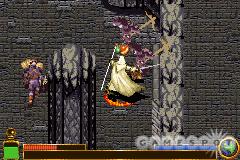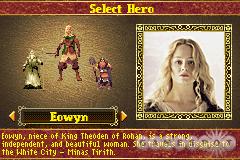All three films in New Line Cinema's The Lord of the Rings trilogy were filmed by the same director in the same locations using the same set of actors. That sort of continuity makes it easy to watch all three films one after another without losing touch with the story, because you're already familiar with the characters and settings by the time you dive into the subsequent chapters. Electronic Arts has taken a similar path with its Lord of the Rings video game series on the Game Boy Advance. The Lord of the Rings: The Return of the King is identical to 2002's The Lord of the Rings, The Two Towers in terms of characters, gameplay, graphics, and audio, but just as the final chapter in the movie trilogy is more complex than the one before it, this last chapter in the game series gives players more variety and more inroads into the settings and events of J.R.R. Tolkien's beloved mythology.

At its core, The Return of the King has the most in common with games like Diablo and Gauntlet. The viewpoint is isometric, and you're pretty much free to roam anywhere you want within the confines of the area you're in. Structures such as houses and caves often contain small dungeons that you can explore in order to find stronger weapons or additional gems. Each area is littered with creatures from the story--orcs, uruk-hai, and such--which leave behind items and contribute to your character's experience points when you defeat them. Items generally come in the form of clothing, shoes, or headgear, which you can equip to improve your defense, damage, and hit-points statistics. Experience points add up until your character gains a level, at which time you earn additional stat points that you can distribute as you like among six different categories. Combat is straightforward. To attack, all you need to do is get close to a monster and press the B button repeatedly. If you want to use spells, you tap the A button. Though the fighting setup doesn't have much depth to it, there's a great deal of variety with respect to the different spells and weapons each character can use.
Each of the eight playable characters has a unique configuration of attributes, magic spells, special skills, and weapon possibilities. Aragorn is strong and can use heavy swords such as long swords and falchions, but he isn't trained in the use of bows, staves, or axes. If you play as Aragorn and pick up these items during the game, you won't be able to use them. As for his spells and special skills, they're mostly related to boosting defense or performing techniques related to the sword. Frodo reflects the other end of the spectrum. He isn't strong enough to use anything but daggers or short swords, but he has a good selection of special skills thanks to his possession of the One Ring. After leveling up a few times, you can put points into Frodo's defense and agility or into spells that allow him to do things like turn invisible or make enemies his allies. The characteristics of the other characters--Gandalf, Eowyn, Gimli, and Legolas--generally reflect the abilities they're portrayed with in the films. Legolas uses a bow, Eowyn is good all around, Gimli is a master with axes, and Gandalf has a great selection of spells. In addition to the six characters that are initially available, there are two secret characters to unlock. One becomes available after you beat the game twice; the other becomes available if you connect the GBA game to the GameCube version using Nintendo's connectivity cable.
Depending on which character you choose, you'll experience different events from the film and visit different locations in the game. Gandalf confronts Saruman and breaks the curse on King Theoden; Aragorn travels from Isengard through the Paths of the Dead and enlists an army of undead in the process; Frodo, Pippen, and Gollum get captured numerous times on their way to Mt. Doom; and so forth. Most players will only need two or three hours to finish the story for each character, but you need to multiply that times six if you intend to visit every location and see every plot point play out. In the previous game, The Two Towers, there was a fair amount of overlap between the characters, events, and locations in the game. The Return of the King does a better job of splitting these aspects up and making it seem as though you're interacting with different chapters of the story.
Those familiar with 2002's The Two Towers game will recognize the menus, play mechanics, and graphics used in The Return of the King. Developer Griptonite Games basically took the engine from the last game and updated it for the current installment. Some improvements have been made here and there, however, and they all add up to make The Return of the King a more satisfying and ultimately more playable sequel. Besides all of the new locations drawn up for the quest mode, the number of dungeons available in the bonus maps and multiplayer modes has doubled compared to the last game. Characters also have twice as many spells and skills available to them, and you now have the option to purchase runes that you can use to strengthen weapons and add side effects to your attacks. Ranger hollows have been put into the game, which allow you to transfer items between the different character saves you set up. This makes it possible to trade rare items you find with one character for items you find with another character so that you can make use of them.
The Return of the King features the same multiplayer mode that was in The Two Towers. Using a link cable, you and a friend can link your games together and work through the maps from the single-player mode cooperatively. Enemies in the multiplayer mode are tougher than those in the single-player game, but the rewards are generally higher as well. One nice thing about the way that characters are saved is that experience and items carry over into each of the game's modes. This means that if you're having trouble in the single-player quest, you can gain some experience by playing bonus levels or by playing with a friend in multiplayer and then pick up where you left off in the single-player game with your newly upgraded character.

The graphics and audio also aren't all that much different between The Return of the King and The Two Towers. Both games do a decent job of bringing the various regions of Middle-earth to life. The characters look similar to their onscreen counterparts and move with a good amount of animation, even if most of that animation involves swinging a sword back and forth. Much of the background music is taken directly from the film soundtrack, and the voice snippets used for the various yells and screams in the game were recorded from the actual actors themselves. Key plot points are displayed with text overlaid on still images captured directly from the movie. Where The Return of the King improves upon its predecessor is in the amount of detail evident in its background graphics. Waterfalls and streams are larger, you can see your character's reflection on various surfaces, and there are more instances where things like torches and blowing leaves add movement to the environment.
The Lord of the Rings: The Return of the King for the Game Boy Advance allows you to relive the story of the film from the perspective of eight major characters, but the game's overall worth comes from aspects that have nothing to do whatsoever with the book or the film. This is a good hack-and-slash RPG that will keep you occupied for hours just building up a character that's useful in all three of the game's separate play modes.